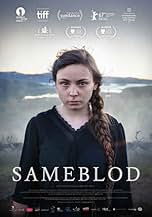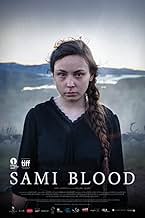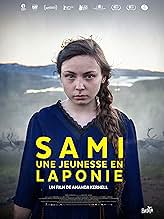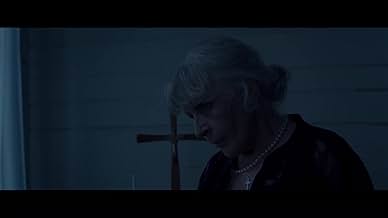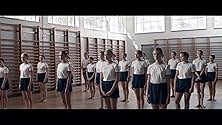VALUTAZIONE IMDb
7,3/10
8595
LA TUA VALUTAZIONE
Una ragazza Sámi che alleva renne che è esposta al razzismo del 1930 nel suo collegio, inizia a sognare un'altra vita.Una ragazza Sámi che alleva renne che è esposta al razzismo del 1930 nel suo collegio, inizia a sognare un'altra vita.Una ragazza Sámi che alleva renne che è esposta al razzismo del 1930 nel suo collegio, inizia a sognare un'altra vita.
- Premi
- 26 vittorie e 18 candidature totali
Maj-Doris Rimpi
- Elle Marja
- (as Maj Doris Rimpi)
- …
Recensioni in evidenza
I am so glad that Amazon carries foreign films like this -- although it takes some digging to find them.
The lead actress was flawless in her role as a native Lapp who is disdained by the Swedish elite. She plays this with such subtlety and dignity. I wanted to hug her and take her away from all the horrible treatment she received. The scenery is great. Hats off to the director for such a magnificent job. I always find that Nordic films are far and away better than American films. "The Hunt" was the most haunting Nordic film I've ever seen. Such a great film Thank you.
Elle Marja, a native of Lapland, faces xenophobia, while suffering a social and cultural wash imposed by Sweden.
I believe that one of the factors that makes this film interesting is the way it explores the subject, in this case, xenophobia and racism, in a country considered by many to be an almost perfect example of modern societies, Sweden.
The story begins with Elle Marja, as a retired teacher, at her sister's funeral, and then takes us into a flashback, where both are young and start attending school.
The process of abandoning culture, the dialect and the mannerisms and gestures themselves is explored in a good way, it fits the time when the individual shapes his personality (adolescence), which allows us to perceive the attitudes that the character adopts throughout the story development.
The photography is very interesting, with that atmosphere of melancholy and loneliness typical of northern European films.
I believe that one of the factors that makes this film interesting is the way it explores the subject, in this case, xenophobia and racism, in a country considered by many to be an almost perfect example of modern societies, Sweden.
The story begins with Elle Marja, as a retired teacher, at her sister's funeral, and then takes us into a flashback, where both are young and start attending school.
The process of abandoning culture, the dialect and the mannerisms and gestures themselves is explored in a good way, it fits the time when the individual shapes his personality (adolescence), which allows us to perceive the attitudes that the character adopts throughout the story development.
The photography is very interesting, with that atmosphere of melancholy and loneliness typical of northern European films.
Sami Blood was so much different than a typical movie about prejudice and culture. Maj-Doris Rimp (Elle Marja) and all the people portraying Sami People were real Laplanders. Obviously, Elle Marja, the lead actor as characterized in the movie came from being raised as a Laplander and that is where she got her education in life because" there is no university like adversity"("the School of Hard Knocks").
What is striking is that unlike typical Swedes or Sami People, Elle Marja understands this desire and social need that all people should acculturate themselves to the cultures of other people who have different values than you--but on your own terms! Why?:Because: "If you see in any given situation only what everybody else can see, you can be said to be so much a representative of your culture that you are a victim of it." ~S. I. Hayakawa
As i watched the people in this movie talking about "Yoiking" (Sami music) I went to YouTube and listened to "Yoik of the Wind." If you were way up in the mountains in the wilderness this is the feeling you would express. The ending of this movie really floored me too and wrapped up the whole picture expressing the character and moral of the story through this woman's finale. By The Way, I'm a 71 year old Irish-American avid movie watcher and found this movie to be well worth watching for anybody. I have never reviewed any movie but couldn't understand why I have never seen SAMI BLOOD" listed on top foreign genre movie lists.
What is striking is that unlike typical Swedes or Sami People, Elle Marja understands this desire and social need that all people should acculturate themselves to the cultures of other people who have different values than you--but on your own terms! Why?:Because: "If you see in any given situation only what everybody else can see, you can be said to be so much a representative of your culture that you are a victim of it." ~S. I. Hayakawa
As i watched the people in this movie talking about "Yoiking" (Sami music) I went to YouTube and listened to "Yoik of the Wind." If you were way up in the mountains in the wilderness this is the feeling you would express. The ending of this movie really floored me too and wrapped up the whole picture expressing the character and moral of the story through this woman's finale. By The Way, I'm a 71 year old Irish-American avid movie watcher and found this movie to be well worth watching for anybody. I have never reviewed any movie but couldn't understand why I have never seen SAMI BLOOD" listed on top foreign genre movie lists.
My Swedish teacher highly recommended me this Swedish film and I had always wanted to watched it. It was played during the Vancouver International Film Festival but I just missed it. Finally, I had an opportunity to watch it. The story of Scandinavian indigenous people in this film reminds of the Salish people in Canada. The indigenous people faced huge invasion in culture, education, territory, etc. They were regarded inferior. Especially young indigenous faced self- identity crisis. They were starting to lose themselves in this modern world. Fortunately, governments start to launch cultural project to rescue indigenous culture. But it is far from enough. Films on this topic are a good ways to let the public know about indigenous culture, language, history and stories.
Background: The Sámi (often called Lapps by outsiders) peoples have occupied the northern regions of the three Nordic countries, and an adjacent part of Russia for at least the past 10,000 years. Totally around 100,000 peoples in the above mentioned geography (another 30,000 in N. America) most today live in urban settings, but traditionally and to a rural extent today they are/were either fishermen or hunter-gathers & herders (especially reindeer). They have historically undergone cultural dissolution, with Norway perhaps the most egregious, surprisingly similar to what Native North Americans underwent.
Story: We encounter an older Elle-Marja (but for sometime re-naming herself Christina) at the funeral of her deceased sister, Njenna, we then go into a flashback of her life starting as a young women who leaves her reindeer herding life to pursue a different education, and a life fraught w/danger as she tries to assimilate into a xenophobic/racist Swedish life.
Lo sapevi?
- QuizAll the Sámi characters are played by real life Sámi people.
- Citazioni
Elle Marja: [to Njenna] Don't yoik at school...
- ConnessioniEdited from Stoerre Vaerie (2015)
I più visti
Accedi per valutare e creare un elenco di titoli salvati per ottenere consigli personalizzati
- How long is Sami Blood?Powered by Alexa
Dettagli
- Data di uscita
- Paesi di origine
- Siti ufficiali
- Lingue
- Celebre anche come
- Sameblod
- Aziende produttrici
- Vedi altri crediti dell’azienda su IMDbPro
Botteghino
- Lordo in tutto il mondo
- 442.416 USD
- Tempo di esecuzione1 ora 50 minuti
- Colore
- Proporzioni
- 2.35 : 1
Contribuisci a questa pagina
Suggerisci una modifica o aggiungi i contenuti mancanti


